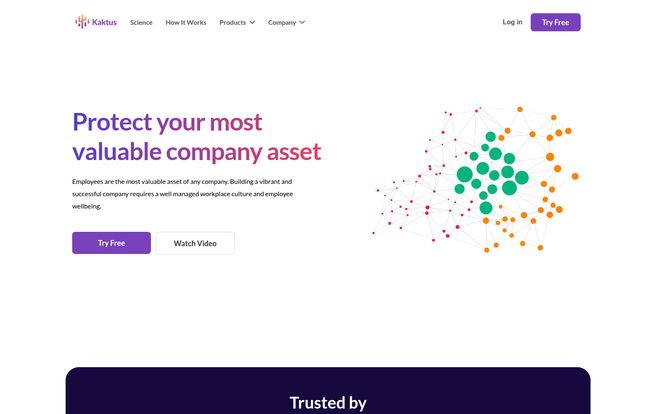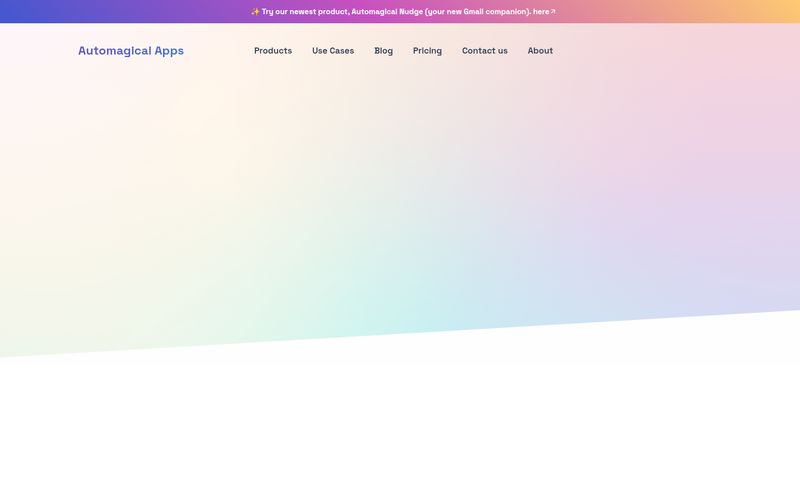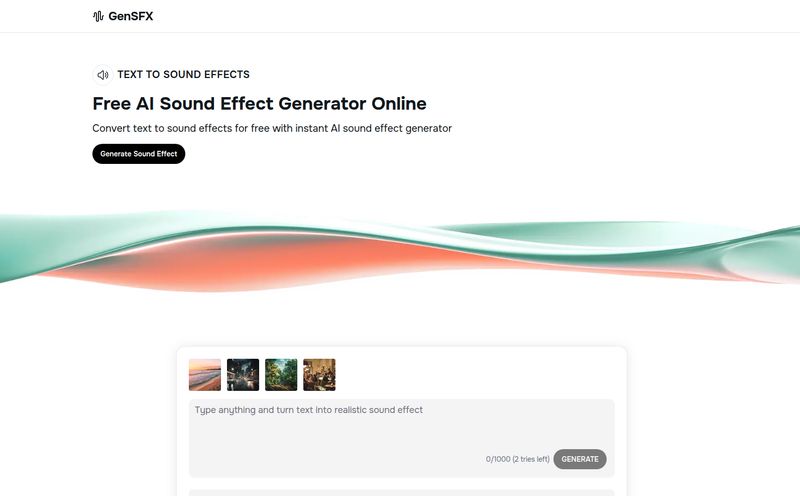I remember a job I had a few years back. Morale was… let’s just say, in the toilet. The big corporate solution? An annual “employee engagement survey.” We’d all tick some boxes, the results would disappear into a black hole for three months, and then management would announce a new pizza party initiative. Groundbreaking stuff, right? We’ve all been there. It felt like trying to fix a sinking ship with a single roll of duct tape.
That's why when I first heard about platforms like Kaktus AI, my inner cynic sat up and paid attention. The pitch is always seductive: using AI to monitor and improve workplace culture in real-time. But as someone who's seen countless 'next-big-things' in HR tech fizzle out, I'm always looking past the shiny landing page. What's actually under the hood?
So, I spent some time digging into Kaktus AI. And what I found was... well, it's pretty interesting. It’s more than just a fancy survey tool; it’s trying to be the central nervous system for a company’s culture and wellbeing.
So What is Kaktus AI, Really?
Forget the annual, backward-looking survey for a second. Kaktus AI is an all-in-one platform that aims to give leaders a live pulse-check on their organization. It mashes together tools for employee engagement, performance feedback, a recognition system, and—this is the big one—mental wellbeing monitoring.
It’s not just about asking people if they’re happy. It's designed to map the invisible currents of your workplace: how teams are interacting, who might be heading for burnout, and what's actually driving performance. The whole idea is to move from being reactive (the pizza party) to being proactive. A pretty ambitious goal, if you ask me.

Visit Kaktus AI
Beyond the Buzzwords: The Features That Matter
A platform is only as good as its features, and Kaktus AI has a lot of them. It's a bit of a smorgasbord, so let's break down the parts that really caught my eye.
The AI-Powered Analytics Core
This is the heart of the platform. Kaktus AI uses its artificial intelligence to analyze data from surveys, feedback, and other communication signals (with privacy in mind, of course). It claims to identify early indicators of mental health triggers like anxiety, depression, and work-related stress. Think of it like a weather forecast for your team's mental climate. Instead of waiting for the storm to hit, you get a heads-up that clouds are forming. For any manager who’s ever been blindsided by a star employee quitting due to burnout, this is a pretty compelling feature.
Getting Things Done with Behavioral Science
Data is useless without action. This is where Kaktus AI's “behavioral nudges” come in. It’s a concept borrowed from behavioral science. Instead of just showing a manager a dashboard full of red flags, the system can send subtle, timely prompts to encourage healthier behaviors. Maybe it’s a nudge to a manager to check in with a team member who’s been working late, or a reminder to an employee to take a short break. It’s like having a little AI coach on your shoulder, whispering helpful suggestions. I’ve always felt this is the missing link in a lot of analytics tools—the bridge between insight and action.
Celebrating Wins and Recognizing People
Let's be honest, a simple "good job" in a team chat gets old. Kaktus AI has a built-in recognition and rewards program. Teams can celebrate achievements, and leaders can design custom rewards through an internal marketplace. This isn't just about gift cards; it's about making recognition a visible, integrated part of the company ethos. It gamifies positive behavior, which, when done right, can be a massive morale booster.
Putting Employees in the Driver's Seat
One of my biggest pet peeves with corporate wellness programs is that they often feel like something being done to employees. Kaktus AI seems to get this. It provides personal wellbeing portals where employees can track their own status, access resources, and get a better handle on their own mental state. This sense of ownership is huge. It reframes wellbeing from a top-down mandate to a personal resource.
The Realistic View: It Can't All Be Perfect
Okay, let's pull back from the marketing copy for a second. No tool is a silver bullet, and I can see a few potential hurdles here based on my experience.
- The Initial Setup: A platform this comprehensive isn't going to be a simple plug-and-play. You'll need to invest time in setting it up, customizing the surveys and modules, and integrating it into your workflow. It requires buy-in from leadership, not just the HR department.
- The Human Element is Still Key: AI can provide incredible insights, but it can't replace a conversation. A manager still needs the emotional intelligence to act on the data correctly. Relying solely on the AI without the human touch could feel a bit... dystopian. You still need good managers.
- Pricing and Commitment: This is a professional-grade tool, and the pricing structure reflects that. It's an investment, and you'll need to be sure your organization is ready to commit to using it properly to see a return.
What's the Damage? A Look at Kaktus AI Pricing
Pricing is always a critical factor. Kaktus AI has a tiered structure that seems pretty standard for the SaaS world. They’ve split it based on company size, which makes sense.
| Plan | Best For | Key Features |
|---|---|---|
| Starter | Small Teams (10-250 employees) | Focuses heavily on the surveying and feedback foundation. You get the smart dashboard, 360 reviews, all the mental health & wellbeing modules, and analytics. It's a great starting point for building a data-driven culture. |
| Standard | Growing Companies (250-999 employees) | This is where the real AI magic kicks in. It adds the behavioral analytics, workplace monitoring, relationship insights, those crucial nudges, and the full recognition/rewards dashboard. For my money, this feels like the complete package. |
| Enterprise | Large Organizations (1000+ employees) | This is the "call us for a quote" plan. Expect a bespoke solution tailored to the complexities of a large-scale enterprise, probably with dedicated support and custom integrations. |
For exact pricing details, you'll need to check their site or get in touch, as these things can change.
My Final Take: Who Should Give Kaktus AI a Shot?
So, who is this for? If you're perfectly happy with your annual survey and pizza parties, this probably isn't for you. And that’s fine.
But if you're a leader who is genuinely tired of guessing games and wants to build a resilient, high-performing, and healthy organization, Kaktus AI is definitely worth a look. It seems particularly well-suited for forward-thinking companies that understand their people are their biggest asset and that mental wellbeing is inextricably linked to performance. It’s for the manager who wants to be a coach, not a firefighter.
Unlike some tools that just focus on one slice of the pie, like engagement or performance, Kaktus AI’s strength is in knitting it all together. The connection between wellbeing, recognition, and performance is something we all know exists, but few tools have tried to manage it all in one place. It's an ambitious platform, and honestly its a bit of a departure from the norm, but that's what makes it so compelling.
Frequently Asked Questions
- Is Kaktus AI just another employee survey tool?
- Not at all. While it has a powerful surveying tool, its main purpose is to provide real-time, AI-driven insights and proactive nudges. The surveys are a data source, not the end product.
- How does Kaktus AI handle employee privacy?
- This is crucial. The platform is GDPR compliant and is designed to work with aggregated and anonymized data for analytics. The goal is to spot trends and patterns to help the organization, not to single out individuals. Personal wellbeing portals are private to the employee.
- Is Kaktus AI suitable for small businesses?
- Yes, the Starter plan is specifically designed for smaller teams of 10-250 employees. It provides the foundational tools for building a strong culture from the ground up, even if you don't have a massive HR department.
- What exactly are the 'behavioral nudges'?
- Think of them as smart, automated reminders or suggestions. For example, if the system notices a team is having too many meetings and not enough focus time, it might nudge the manager to consider a 'no-meeting' block in the calendar. They are small prompts designed to encourage positive actions.
- Do I need to be a data scientist to use the dashboards?
- No. The dashboards and analytics are designed for business leaders and HR managers, not data analysts. The information is presented in a visual, easy-to-understand way with heat maps and clear reports to help you make decisions quickly.
The Future is Proactive
The world of work is changing fast. The old models of management are cracking under the pressure of remote work, burnout culture, and a new generation of workers who expect more from their employers. Tools like Kaktus AI represent a shift in thinking—a move toward a more human-centric, data-informed, and proactive way of managing our most valuable asset: our people. It's not a magic fix, but it's a powerful tool for leaders who are ready to build the workplace of the future, today.



